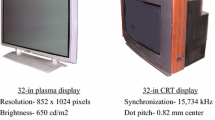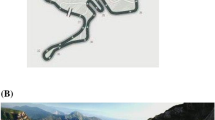Abstract
We examined the influence of passive restraint on postural activity and motion sickness in individuals who actively controlled a potentially nauseogenic visual motion stimulus (a driving video game). Twenty-four adults (20.09 ± 1.56 years; 167.80 ± 7.94 cm; 59.02 ± 9.18 kg) were recruited as participants. Using elastic bands, standing participants were passively restrained at the head, shoulders, hips, and knees. During restraint, participants played (i.e., controlled) a driving video game (a motorcycle race), for 50 min. During game play, we recorded the movement of the head and torso, using a magnetic tracking system. Following game play, participants answered a forced choice, yes/no question about whether they were motion sick, and were assigned to sick and well groups on this basis. In addition, before and after game play, participants completed the Simulator Sickness Questionnaire, which provided numerical ratings of the severity of individual symptoms. Five of 24 participants (20.83 %) reported motion sickness. Participants moved despite being passively restrained. Both the magnitude and the temporal dynamics of movement differed between the sick and well groups. The results show that passive restraint of the body can reduce motion sickness when the nauseogenic visual stimulus is under participants’ active control and confirm that motion sickness is preceded by distinct patterns of postural activity even during passive restraint.






Similar content being viewed by others
References
Bonnet CT, Faugloire E, Riley MA, Bardy BG, Stoffregen TA (2006) Motion sickness preceded by unstable displacements of the center of pressure. Hum Mov Sci 25(6):800–820
Bonnet CT, Faugloire E, Riley MA, Bardy BG, Stoffregen TA (2008) Self-induced motion sickness and body movement during passive restraint. Ecol Psychol 20(2):121–145
Chang C-H, Pan W–W, Tseng L-Y, Stoffregen TA (2012) Postural activity and motion sickness during video game play in children and adults. Exp Brain Res 217:299–309
Chen Z, Ivanov PC, Hu K, Stanley HE (2002) Effect of nonstationarities on detrended fluctuation analysis. Phys Rev E 65:041107
Chen Y-C, Dong X, Chen F-C, Stoffregen TA (2012) Control of a virtual avatar influences postural activity and motion sickness. Ecol Psychol 24(4):279–299
Cohen J (1988) Statistical power analysis for the behavioral sciences, 2nd edn. Erlbaum, Hillsdale
Dong X, Yoshida K, Stoffregen TA (2011) Control of a virtual vehicle influences postural activity and motion sickness. J Exp Psychol Appl 17:128–138
Faugloire E, Bonnet CT, Riley MA, Bardy BG, Stoffregen TA (2007) Motion sickness, body movement, and claustrophobia during passive restraint. Exp Brain Res 177(4):520–532
Howell DC (1997) Statistical methods for psychology, 4th edn. Wadsworth Publishing Company, Belmont
Johnson WH, Mayne JW (1953) Stimulus required to produce motion sickness; restriction of head movement as a preventive of airsickness; field studies on airborne troops. J Aviat Med 24:400–411
Johnson WH, Taylor NBG (1961) Some experiments on the relative effectiveness of various types of accelerations on motion sickness. Aerosp Med 32:205–208
Kennedy RS, Lilienthal MG (1994) Measurement and control of motion sickness aftereffects from immersion in virtual reality. In: Proceedings of “virtual reality and medicine: the cutting edge”. SIG-Advanced Applications, Inc., New York, pp 111–119
Kennedy RS, Lane NE, Berbaum KS, Lilienthal MG (1993) Simulator sickness questionnaire: an enhanced method for quantifying simulator sickness. Int J Aviat Psychol 3:203–220
Lackner JR, Graybiel A, DiZio PA (1991) Altered sensorimotor control of the body as an etiological factor in space motion sickness. Aviat Space Environ Med 62:765–771
Lin D, Seol H, Nussbaum MA, Madigan ML (2008) Reliability of COP-based postural sway measures and age-related differences. Gait and Posture 28:337–342
Merhi O, Faugloire E, Flanagan M, Stoffregen TA (2007) Motion sickness, console video games, and head-mounted displays. Hum Factors 49:920–934
Miller JW, Goodson JE (1960) Motion sickness in a helicopter simulator. Aerosp Med 31:204–212
Mills KL, Griffin MJ (2000) Effect of seating, vision and direction of horizontal oscillation on motion sickness. Aviat Space Environ Med 71:996–1002
Oman CM (1982) A heuristic mathematical model for the dynamics of sensory conflict and motion sickness. Acta Oto-Laryngologica Suppl 392:44
Reason JT (1978) Motion sickness adaptation: a neural mismatch model. J R Soc Med 71:819–829
Riccio GE, Stoffregen TA (1991) An ecological theory of motion sickness and postural instability. Ecol Psychol 3:195–240
Rolnick A, Lubow RE (1991) Why is the driver rarely motion sick? The role of controllability in motion sickness. Ergonomics 34:867–879
Stoffregen TA (1985) Flow structure versus retinal location in the optical control of stance. J Exp Psychol Hum Percept Perform 11(5):554–565
Stoffregen TA, Smart LJ (1998) Postural instability precedes motion sickness. Brain Res Bull 47:437–448
Stoffregen TA, Faugloire E, Yoshida K, Flanagan MB, Merhi O (2008) Motion sickness and postural sway in console video games. Hum Factors 50:322–331
Acknowledgments
The experiments were conducted as part of the master’s thesis of Wu-Wen Pan at National Kaohsiung Normal University, Taiwan.
Author information
Authors and Affiliations
Corresponding author
Rights and permissions
About this article
Cite this article
Chang, CH., Pan, WW., Chen, FC. et al. Console video games, postural activity, and motion sickness during passive restraint. Exp Brain Res 229, 235–242 (2013). https://doi.org/10.1007/s00221-013-3609-y
Received:
Accepted:
Published:
Issue Date:
DOI: https://doi.org/10.1007/s00221-013-3609-y




